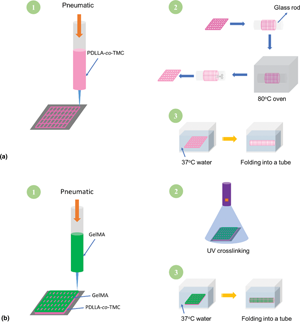Crossref Citations
This article has been cited by the following publications. This list is generated based on data provided by
Crossref.
Lai, Jiahui
Wang, Chong
and
Wang, Min
2021.
3D printing in biomedical engineering: Processes, materials, and applications.
Applied Physics Reviews,
Vol. 8,
Issue. 2,
Kumar, Prasoon
Mirza, Khalid Baig
Choudhury, Kaushik
Cucchiarini, Magali
Madry, Henning
and
Shukla, Pratyoosh
2021.
Tissue Regeneration through Cyber‐Physical Systems and Microbots.
Advanced Functional Materials,
Vol. 31,
Issue. 31,
Lai, Jiahui
Ye, Xinliang
Liu, Jia
Wang, Chong
Li, Junzhi
Wang, Xiang
Ma, Mingze
and
Wang, Min
2021.
4D printing of highly printable and shape morphing hydrogels composed of alginate and methylcellulose.
Materials & Design,
Vol. 205,
Issue. ,
p.
109699.
Afzali Naniz, Moqaddaseh
Askari, Mohsen
Zolfagharian, Ali
Afzali Naniz, Mehrdad
and
Bodaghi, Mahdi
2022.
4D printing: a cutting-edge platform for biomedical applications.
Biomedical Materials,
Vol. 17,
Issue. 6,
p.
062001.
Vahabli, Ebrahim
Mann, James
Heidari, Behzad Shiroud
Lawrence‐Brown, Michael
Norman, Paul
Jansen, Shirley
De‐Juan‐Pardo, Elena
and
Doyle, Barry
2022.
The Technological Advancement to Engineer Next‐Generation Stent‐Grafts: Design, Material, and Fabrication Techniques.
Advanced Healthcare Materials,
Vol. 11,
Issue. 13,
Arif, Zia Ullah
Khalid, Muhammad Yasir
Zolfagharian, Ali
and
Bodaghi, Mahdi
2022.
4D bioprinting of smart polymers for biomedical applications: recent progress, challenges, and future perspectives.
Reactive and Functional Polymers,
Vol. 179,
Issue. ,
p.
105374.
Aldawood, Faisal Khaled
2023.
A Comprehensive Review of 4D Printing: State of the Arts, Opportunities, and Challenges.
Actuators,
Vol. 12,
Issue. 3,
p.
101.
Lai, Jiahui
and
Wang, Min
2023.
Developments of additive manufacturing and 5D printing in tissue engineering.
Journal of Materials Research,
Vol. 38,
Issue. 21,
p.
4692.
Naniz, Moqaddaseh Afzali
Askari, Mohsen
Zolfagharian, Ali
and
Bodaghi, Mahdi
2023.
Nano- and Microfabrication Techniques in Drug Delivery.
Vol. 2,
Issue. ,
p.
207.
Wu, Hanning
Chen, Jiawen
Zhao, Pengxiang
Liu, Mengyu
Xie, Fei
and
Ma, Xuemei
2023.
Development and Prospective Applications of 3D Membranes as a Sensor for Monitoring and Inducing Tissue Regeneration.
Membranes,
Vol. 13,
Issue. 9,
p.
802.
Lai, Jiahui
Liu, Yuwei
Lu, Gang
Yung, Patrick
Wang, Xiaoying
Tuan, Rocky S.
and
Li, Zhong Alan
2024.
4D bioprinting of programmed dynamic tissues.
Bioactive Materials,
Vol. 37,
Issue. ,
p.
348.
Moheb Afzali, Amirreza
Kheradmand, Mohammad Amin
and
Naghib, Seyed Morteza
2024.
Bioreactor design-assisted bioprinting of stimuli-responsive materials for tissue engineering and drug delivery applications.
Bioprinting,
Vol. 37,
Issue. ,
p.
e00325.
Demoly, Frédéric
and
André, Jean-Claude
2024.
4D Printing: Bridging the Gap between Fundamental Research and Real-World Applications.
Applied Sciences,
Vol. 14,
Issue. 13,
p.
5669.
Chen, Xiao-Die
Zhang, Xin-Yang
Zhu, Han-Qi
Lu, Helen H.
and
Wang, Min
2024.
Three-Dimensional Printing of Hydrogel Blend Tissue Engineering Scaffolds with In Situ Delivery of Anticancer Drug for Treating Melanoma Resection-Induced Tissue Defects.
Journal of Functional Biomaterials,
Vol. 15,
Issue. 12,
p.
381.
Lai, Jiahui
Chen, Xiaodie
Lu, Helen H.
and
Wang, Min
2024.
3D Bioprinting of Graphene Oxide-Incorporated Hydrogels for Neural Tissue Regeneration.
3D Printing and Additive Manufacturing,
Vol. 11,
Issue. 6,
p.
e2022.
Chambers, Lindsay B.
Zhu, Yuxiang
Yu, Churan
Crutchfield, Natalie
Hou, Jixin
Liang, Liang
Wang, Xianqiao
Liu, Yang
Sobczak, M. Taylor
Theobald, Taylor
Sun, Xiao
Stoll, Carly R.
Pulido, Tiffany V.
Yi, Johnny
Cornella, Jeffrey L.
McIlwee, Heather
Handa, Hitesh
Brisbois, Elizabeth J.
Lancaster, Jessica N.
and
Song, Kenan
2025.
3D printable biopolymers as pelvic floor scaffolds.
Polymer Chemistry,
Vol. 16,
Issue. 3,
p.
345.
Idumah, Christopher Igwe
Okoye, Ifeanyi Emmanuel
and
Ikebudu, Chioma Joan
2025.
Emerging Advances in 3-D & 4-D Printing of Polymeric Nanoarchitectures & Multifacet Applications.
Recent Progress in Materials,
Vol. 07,
Issue. 01,
p.
1.
Wang, Zhe
Ma, Duo
Liu, Juan
Xu, Shi
Qiu, Fang
Hu, Liqiu
Liu, Yueming
Ke, Changneng
and
Ruan, Changshun
2025.
4D printing polymeric biomaterials for adaptive tissue regeneration.
Bioactive Materials,
Vol. 48,
Issue. ,
p.
370.




